Physical Address
304 North Cardinal St.
Dorchester Center, MA 02124
Since both the distal common bile duct and the main pancreatic duct converge at the level of the ampulla, ampullary tumors ( Box 42.1 ) may obstruct two organs, which may lead to early onset of symptoms. However, the potential for early detection has improved the prognosis for neoplasms of the ampulla, especially in comparison with other pancreatobiliary tumors. New techniques that are being used for local treatment, such as endoscopic polypectomy and transduodenal ampullectomy, have created challenges with regard to pathological analysis of ampullary tumors. These are discussed more thoroughly in the following sections.
Adenomas of ampullary duodenum
Intraampullary papillary-tubular neoplasm
Flat dysplasia
Pancreatobiliary-type adenocarcinoma
Intestinal-type adenocarcinoma
Mucinous (colloid) carcinoma
Poorly cohesive carcinoma (with/without signet-ring cells)
Adenosquamous carcinoma
Medullary carcinoma
Micropapillary carcinoma
Undifferentiated carcinoma
Well-differentiated neuroendocrine tumor
Not otherwise specified
Gastrinoma
Somatostatinoma (glandular psammomatous carcinoid)
Poorly differentiated neuroendocrine carcinoma
Small cell neuroendocrine carcinoma
Large cell neuroendocrine carcinoma
Mixed neuroendocrine–nonneuroendocrine neoplasm (MiNEN)
Gangliocytic paraganglioma
Paraduodenal pancreatitis
Adenomyomatous hyperplasia (“adenomyoma”)
Others
In this chapter, the term ampulla refers to the entire ampullary structure, which includes all four compartments ( Table 42.1 ). The word papilla is discouraged so it is not confused with papilla-forming neoplasms, but when it is used, it typically refers to the pinnacle (edge) of the ampullary prominence ( Figs. 42.1 to 42.3 ). For lesions that arise from or are localized preferentially at the duodenal surface of the ampulla, the term ampullary duodenum should be used. Although the term periampullary duodenum has also been used in publications to describe this particular anatomical region, it is not used in this chapter to avoid confusion.
| Term | Synonyms Used in This Chapter | Description |
|---|---|---|
| Ampulla of Vater (see Fig. 42.1 ) | Major ampulla | Protuberance in the second portion of the duodenum composed of (1) duodenal mucosa, (2) papilla of Vater lined by mixed epithelia, (3) pancreatobiliary-type ductules embedded in myoid tissue of the sphincter of Oddi or duodenal musculature, and (4) distal ends of the common bile and pancreatic ducts |
| Ampullary duodenum (see Fig. 42.5 ) | Duodenal surface of ampulla | Duodenum-facing surface of the ampulla, which is mostly lined by intestinal-type epithelium |
| Papilla of Vater (see Figs. 42.1 and 42.3 ) | None | Refers specifically to the protuberance (edge of the pinnacle) of the ampulla, lined by mixed epithelia including specialized epithelium with mucinous features and scattered Goblet cells. Its wall is composed of pancreatobiliary-type ductules embedded in myoid tissue of the sphincter of Oddi or duodenal musculature |
| Ampullary duct (see Figs. 42.2 and 42.6 ) | None | Refers to pancreatobiliary-type ductules and peribiliary mucous glands as well as the duct epithelium of the very distal segments of the common bile duct and the main pancreatic duct |
| Minor ampulla (see Fig. 42.3 ) | Accessory ampulla | Located 2 cm proximal and anterior to the ampulla of Vater (major ampulla), within the duodenum |
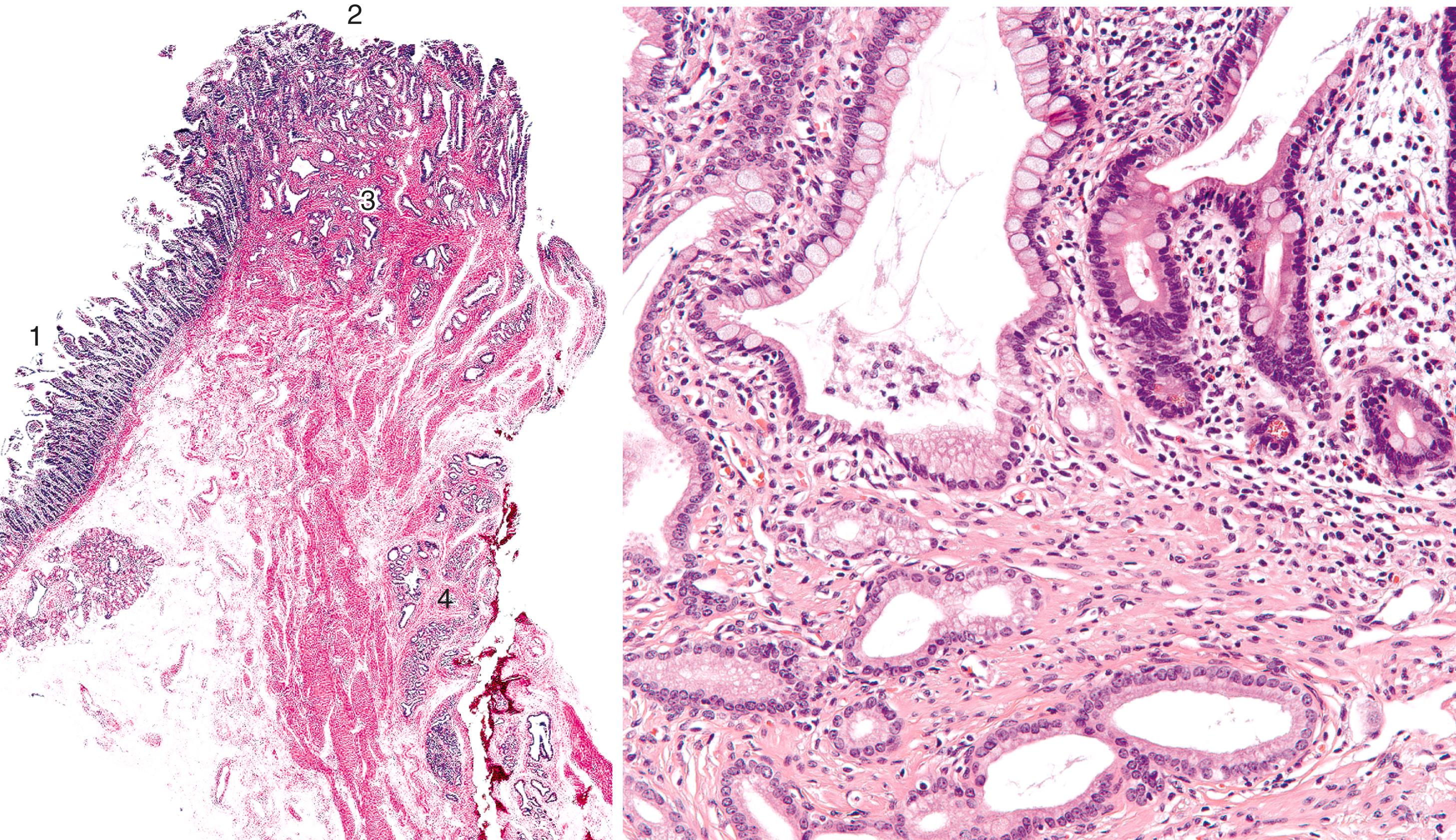
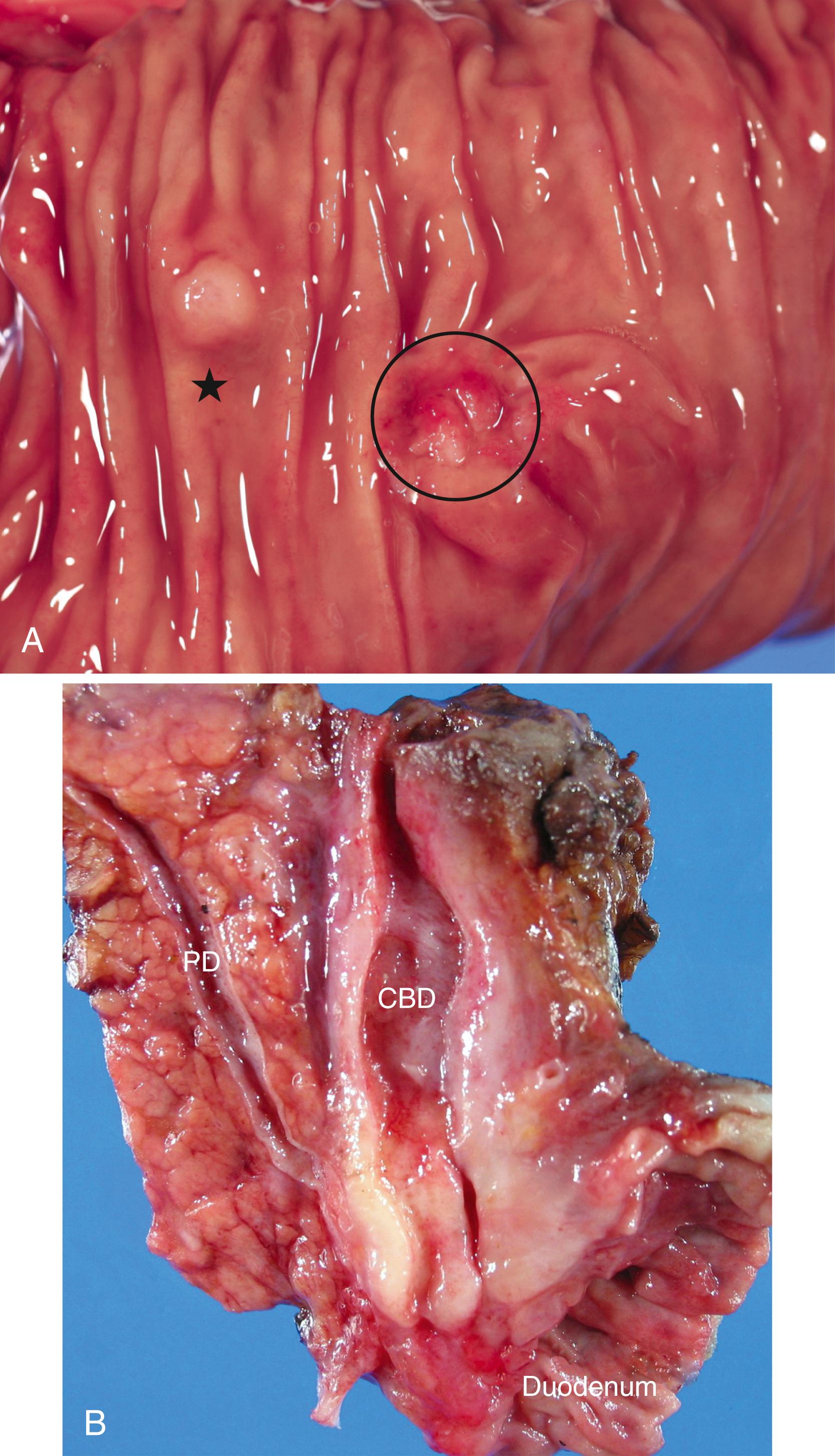
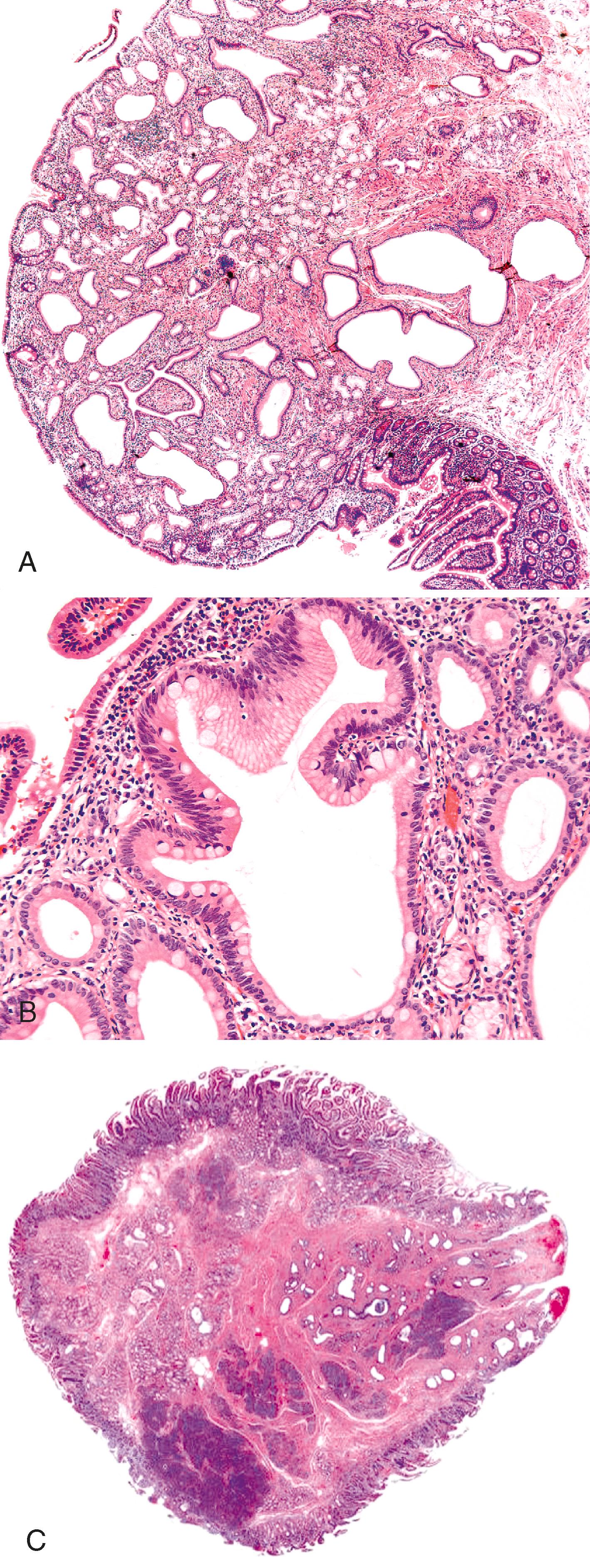
The anatomy of the ampulla of Vater (major ampulla) can vary considerably among individuals. In most people, the common bile duct and the main pancreatic duct join into a common channel within the wall of the duodenum. Flow of luminal material through the ampulla is regulated by dense fascicles of smooth muscle, called the sphincter of Oddi (see Fig. 42.1A ). The mucosa forms folds called plicae . Although the length of the common channel varies, it is less than 3 mm long in most individuals. In some individuals, the common bile duct and the main pancreatic duct are separated by a septum. These anatomical variations are difficult to demonstrate in routine examination of surgical specimens unless dye injection or specimen radiographs are performed.
The minor ampulla (accessory ampulla) is also subject to anatomical variations. It is typically located 2 cm proximal and anterior to the ampulla of Vater (major ampulla) within the duodenum (see Fig. 42.2A ). It can be mistaken for a polyp endoscopically. The dorsal pancreatic duct (Santorini) drains through the minor ampulla. Although this duct usually regresses with fetal maturation, residual duct elements often remain in the submucosa of the duodenum. The minor ampulla is patent in approximately 40% of the population. , The composition of the minor ampulla varies among individuals.
The epithelium of both ampullae is small intestinal–type on the duodenal surface. At the edge of the ampullae, where the ducts open to the duodenum (i.e., the papilla), a specialized epithelium with features that resemble gastric-foveolar epithelium with scattered goblet cells is often present (see Figs. 42.1B and 42.3B ). Because of the presence of mucinous epithelium, biopsy specimens from this area can be mistaken for peptic injury. Pancreatobiliary-type ductules lie within the wall of the ampullae (see Fig. 42.1B ). These structures are usually embedded in dense myoid tissue of the sphincter of Oddi or duodenal musculature (see Fig. 42.1B ). Pancreatic acinar lobules often reside in the wall of the ampullae as well (see Fig. 42.3C ). They may contain islets of Langerhans. Clusters of neuroendocrine cells may also occur in the minor ampulla, but only rarely in the ampulla of Vater.
Various criteria to determine whether a particular tumor originates in the ampulla or in the nonampullary duodenum have been described in the literature. Inconsistent use of the term periampullary has further complicated the issue. In some publications, it refers to the ampullary region proper, whereas in others it is used to describe the nonampullary segment of the duodenum. ,
A more specific definition of the ampulla is as follows , , : Tumors are defined as ampullary if more than 75% of the tumor is either localized to, or engulfed by, the ampulla and the preinvasive component (if present) is located within one of the four compartments of the ampulla. The four subtypes of ampullary carcinomas are classified according to their primary site of growth: ampullary, not otherwise specified (AMP-NOS); intraampullary papillary-tubular neoplasm (IAPN)-associated; ampullary duct; and ampullary duodenum , , ( Table 42.2 ; see Figs. 42.2 and 42.4 to 42.6 ):
AMP-NOS carcinomas involve the edge of the ampullary orifice (i.e., the papilla of Vater) ( Fig. 42.7 ; see Figs. 42.1B and 42.3B ), which is lined by mixed epithelia including intestinal-type, pancreatobiliary-type, and specialized epithelium with mucinous features resembling gastric-foveolar epithelium as well as scattered goblet cells.
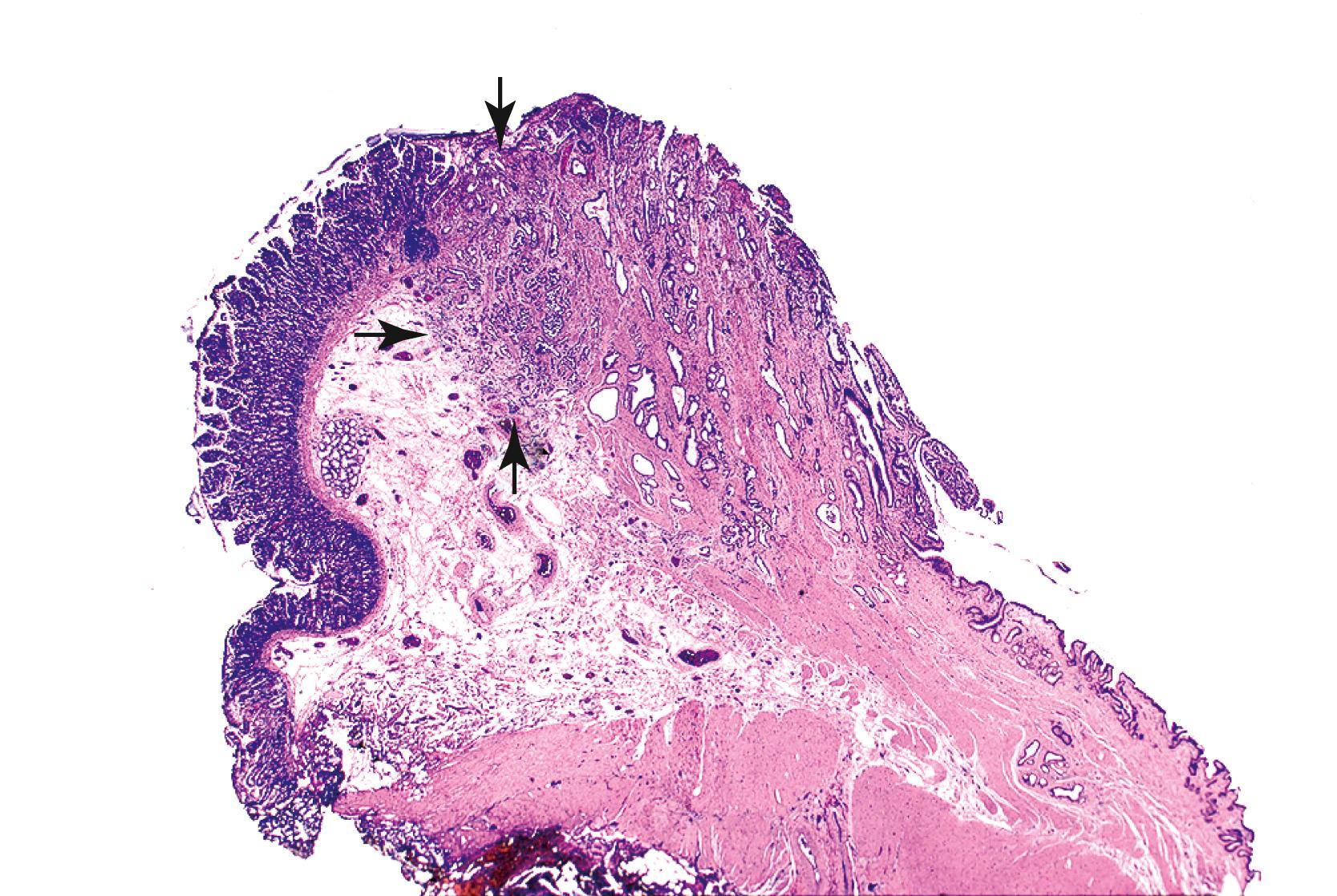
IAPN-associated carcinomas arise from the distalmost ends of the common bile duct and pancreatic duct, which are lined by simple cuboidal to columnar epithelium (see Figs. 42.1A and 42.5 ).
Carcinomas of the ampullary duct involve the wall of the papilla of Vater. The wall is composed of pancreatobiliary-type ductules, peribiliary mucous glands, and myoid tissue of the sphincter of Oddi complex, which merges with the duodenal musculature (see Fig. 42.1 ).
Carcinomas of the ampullary duodenum arise from the duodenal surface of the prominence (see Figs. 42.1A and 42.5 ).
| Subtype of Ampullary Carcinoma | Luminal Findings | Status of Ampullary Orifice | Cut Section Appearance | Findings in the Distal Segments of the Common Bile and Pancreatic Duct |
|---|---|---|---|---|
| Ampullary-NOS (papilla of Vater) | Ulceration and/or polypoid lesion localized in the ampulla | Centrally located | White, firm lesion involving the papilla of Vater | Nondescript tumor involvement of the distal tips |
| Intraampullary papillary-tubular neoplasm associated | Dilated ampullary orifice with protruding polypoid granular material | Centrally located; dilated orifice, easily probable | Preinvasive (polypoid/granular) exophytic lesion within ampullary channel and distal segments of the ducts | Filled with papillary nodular or granular material; often significantly dilated |
| Ampullary duct | Minimal changes; button-like mucosal-covered elevation or subtle ulceration or minimal granulation | Centrally located; often relatively difficult to probe | Scirrhous, plaquelike, constrictive, and often subtle lesion on the wall of the papilla of Vater and distal segments of the ducts | Scarlike firmness on the walls, often concentric |
| Ampullary duodenum | Prominent ulcero-vegetating nodules on the duodenal surface of the ampulla | Eccentrically located; difficult to probe in some cases | Granular, nodular tumor on the duodenal surface, pushing into the inner structures | Variable secondary destruction by invasion of the duodenal surface lesion |
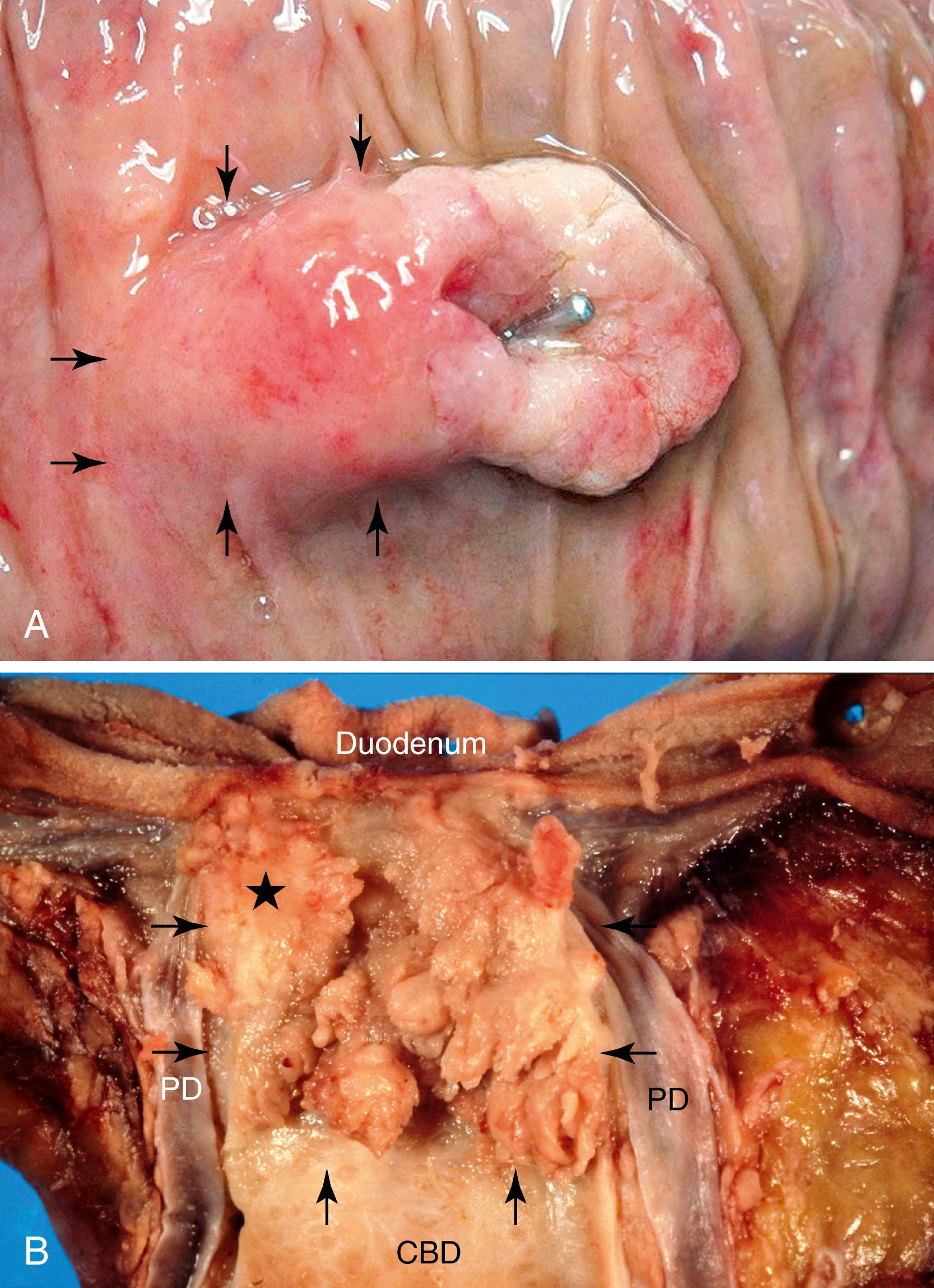
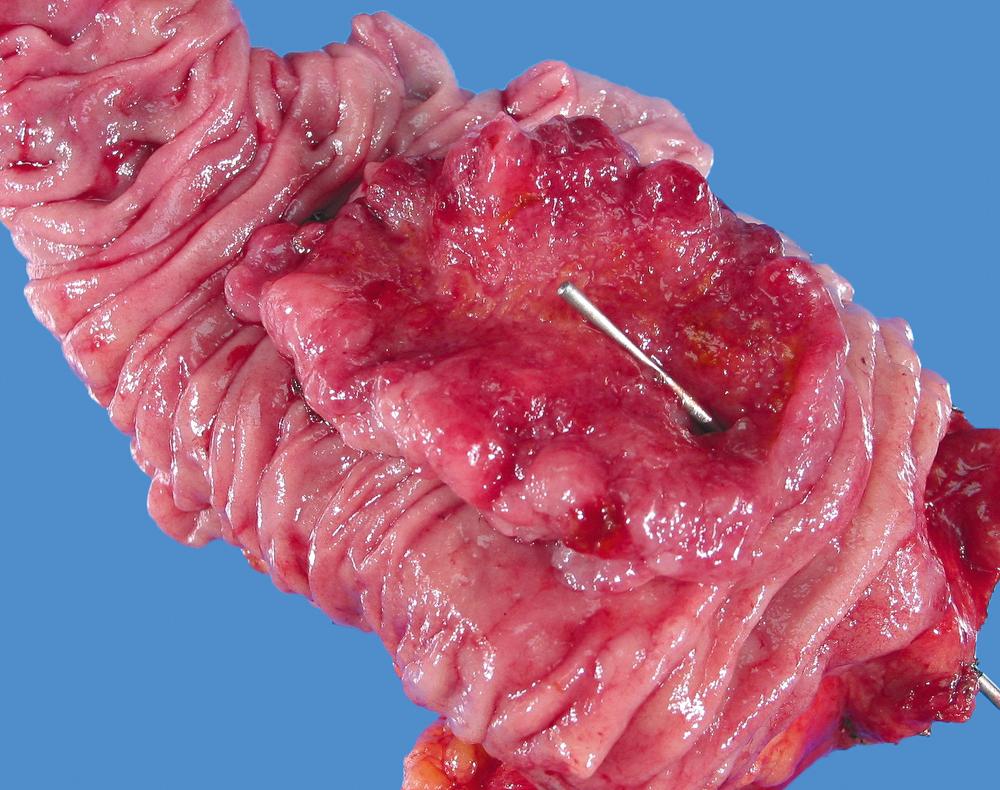

Adenomas of the intestinal type, similar in appearance to colorectal adenomas, may arise and grow in the ampullary duodenum (i.e., duodenal surface of the ampulla). In the small intestine, the ampulla is a particularly common site of adenoma development, presumably because this is an anatomical site that is prone to chemical or physical injury. Most ampullary adenomas are sporadic, but the ampullary and other parts of the duodenum are the most common sites of extracolonic adenomas in patients with familial adenomatous polyposis (FAP). Between 80% and 90% of patients with FAP develop multiple adenomas in the duodenum, and 25% occur in the ampullary duodenum. Symptomatic adenomas are usually detected within 10 to 15 years of colectomy in FAP patients. Fortunately, because FAP screening protocols include periodic endoscopic surveillance of the duodenum, adenomas are increasingly detected at an earlier stage of development, while they are still asymptomatic.
Adenomas of ampullary duodenum often extend inside the ampulla and involve its distal common bile duct/main pancreatic duct segments. By definition, more than 75% of the lesion should be located on the duodenal surface of the ampulla for it to be classified as an adenoma of the ampullary duodenum. Tumors with complete or near-complete intrapapillary growth are classified as IAPNs.
Patients with sporadic adenomas of the ampullary duodenum are an average of 60 years of age. In contrast, FAP patients are typically 20 years younger at the time of diagnosis. , Sporadic cases have a female predilection, whereas both sexes are affected equally by FAP. , , , Clinical symptoms vary. Larger adenomas may cause bile duct obstruction with jaundice, abdominal pain, and pancreatitis. Smaller adenomas are often asymptomatic. Gastrointestinal (GI) hemorrhage is rare and raises concerns regarding the existence of an invasive carcinoma. However, invasive carcinomas that arise in adenomas are often hidden at the base of the polyp and are difficult to detect in surface biopsies. Of note, adenomas of the ampullary duodenum are more likely to harbor an invasive carcinoma than similarly sized colorectal adenomas. The prevalence of carcinoma increases proportionately with the size of the polyp. , , ,
Adenomas are classified as tubular, tubulovillous, or villous, depending on the amount of glandular and papillary architecture. Tubulovillous adenomas contain more than 25% villi, and villous adenomas contain more than 75% villi. Tubular, villous, and tubulovillous adenomas occur with equal frequency in sporadic cases. However, tubular adenomas are more common in patients with FAP. Villous adenomas tend to be larger than tubular or tubulovillous adenomas, and they are more likely to harbor a carcinoma.
Grossly, most tubular adenomas of the ampullary duodenum are bosselated in appearance, whereas most villous adenomas have a feathery or papillary appearance ( Fig. 42.8 ). , A firm texture or the presence of surface ulceration should always raise concern of an invasive component.

Microscopically, adenomas of the ampullary duodenum are similar to those that occur in the large intestine. They are composed of tubules and/or villi (papillae) lined by columnar cells with elongated, hyperchromatic, pencil-shaped nuclei and nuclear pseudostratification. The amount of cytoplasmic mucin varies. Goblet cells may be present, but they are not usually numerous. Some FAP-associated cases may be quite subtle, in some cases showing surface maturation.
By definition, all adenomas are dysplastic. Dysplasia is categorized as low grade or high grade, depending on the degree of cytological and architectural atypia. Low-grade dysplasia consists of pseudostratified, relatively monotonous columnar cells with cigar-shaped, elongated nuclei. The nuclei are mostly lined up in the basal aspect of the cell cytoplasm, and there is no, or only mild, pleomorphism and loss of nuclear polarity. High-grade dysplasia is characterized by marked nuclear pleomorphism, loss of polarity, increased nucleus-to-cytoplasm ratio, and increased mitoses combined with architectural complexity, such as cribriforming, back-to-back glands, and micropapillae formation.
Paneth cells and neuroendocrine cells are particularly common in all ampullary adenomas, and in some cases they can form more than 50% of the neoplastic cell population, particularly in FAP. Rare cases contain independent clusters of neuroendocrine cells at the base of the adenoma. Immunohistochemical staining reveals intestinal differentiation, such as positivity for cytokeratin (CK)20, CDX2, and MUC2. , CK7 is also commonly positive in these tumors. , Paneth cells label for lysozyme, and the neuroendocrine cell component can be detected with chromogranin and/or synaptophysin. , , ,
Extension of adenomatous epithelium into ductules located in the wall of the papilla can simulate invasive carcinoma, particularly where continuity with the normal surface epithelium is lost and high-grade dysplasia is present. Because of the complexity of ductular structures, it may be difficult or even impossible to distinguish a preinvasive lesion from true invasion in some cases ( Fig. 42.9 ). Findings such as paradoxical differentiation (i.e., different cytomorphology in preinvasive vs. invasive components), cuboidal epithelium, dispersion in a nonlobular and nonorganoid fashion, formation of complex micropapillary tufts or markedly elongated gland units, marked contour irregularities, and severe cytological atypia all favor invasive carcinoma ( Table 42.3 ). Budding and vascular or perineural invasion are also helpful findings for a diagnosis of invasion. Unfortunately, in some cases invasion can be expansile (i.e., nodular or pushing border), without evidence of a conventional infiltration pattern.

| Findings | Invasive | Preinvasive |
|---|---|---|
| Dispersion of glands | +++ | − |
| Lobularity | − | +++ |
| Clustering of evenly shaped glands | − | +++ |
| Cytological discrepancy with the surface component | ++ | − |
| Loss of cell polarity | ++ | ± |
| Contour irregularities | ++ | − |
Another diagnostic dilemma arises when an underlying invasive carcinoma of the pancreas or bile duct involves the ampullary epithelium by colonization (“cancerization”) of the mucosal basement membrane, which simulates a preinvasive component ( Fig. 42.10 ). This process is termed pseudoadenomatous transformation . This process can be very innocuous. It often forms scattered units that appear to be out of context. In these cases, immunohistochemical stains may help demonstrate that both components have the same type of pancreatobiliary (rather than intestinal) differentiation and are positive for only CK7 (rather than both CK7 and CK20) and for MUC1 (rather than MUC2 and CDX2).

Reactive changes associated with inflammatory processes of the ampulla can also mimic an adenoma ( Fig. 42.11 ). However, in addition to having associated inflammation, reactive changes usually lack the degree of nuclear elongation and pseudostratification characteristic of dysplasia. Paradoxically, reactive nuclei occasionally show more severe atypia than low-grade dysplasia, in the form of nuclear enlargement and macronucleoli. Reactive epithelium may also reveal a higher degree of cytoplasmic eosinophilia than dysplasia, presumably because it does not contain abnormal mucins. Nevertheless, architectural complexity, a characteristic feature of high-grade dysplasia, is not seen in reactive epithelium.

Adenomatous lesions that occur within the papilla and distal common bile duct (i.e., IAPNs) have several distinctive characteristics that distinguish them from adenomas of the ampullary duodenum as discussed in the following sections.
IAPNs are adenomatous (tumoral, intraepithelial, neoplastic) lesions that occur almost exclusively in the ampulla (see Fig. 42.4 ). , They represent the intraampullary counterpart of intraductal neoplasms of the pancreas and biliary tract (see Chapter 38, Chapter 40 ). Papillary or polypoid tumors can fill the ampullary channel and distal segment of the common bile duct, or they can fill the main pancreatic duct (see Fig. 42.4 ). By definition, involvement of the ampullary duodenum and intramucosal extension into the proximal aspect of the common bile duct and the main pancreatic duct is minimal (<25%). Although adenomas of the ampullary duodenum are almost invariably of intestinal type and are morphologically identical to colonic adenomas, IAPNs commonly exhibit nonintestinal phenotypes.
These tumors account for one-third of all pancreatoduodenectomies performed for a clinical diagnosis of an ampullary tumor. The mean age of affected patients is 64 years (range, 27 to 85 years), and these tumors occur predominantly in men (male-to-female ratio of 2.2). Symptoms (e.g., jaundice, pruritus, light stool, dark urine) are usually related to obstruction of the common bile duct, but patients also may have nonspecific symptoms such as abdominal pain and weight loss.
Become a Clinical Tree membership for Full access and enjoy Unlimited articles
If you are a member. Log in here